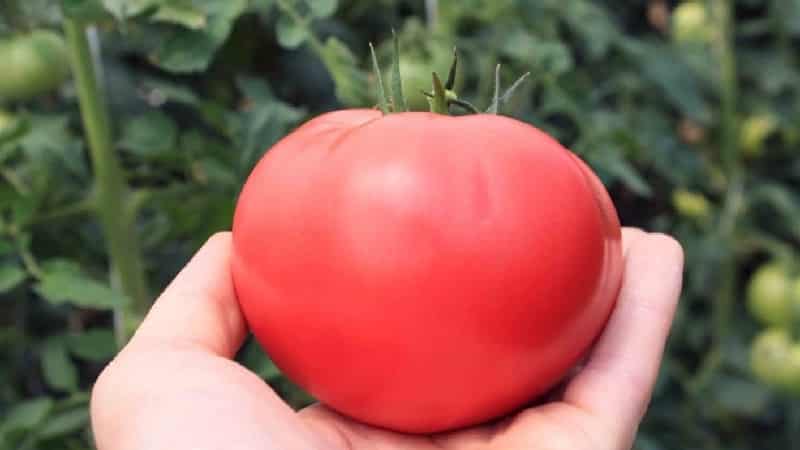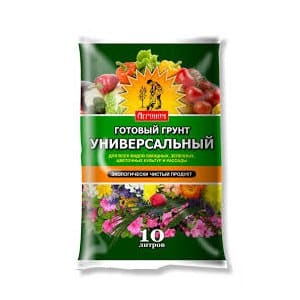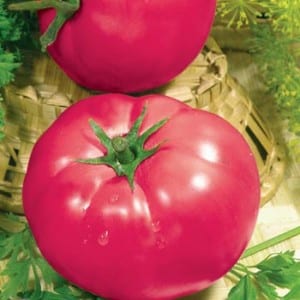A recognized favorite among gardeners is the “Rosy Cheeks” tomato.
Over the course of their existence, tomatoes have been called differently. And golden apples and wolf peaches. At all times, increased attention was paid to the vegetable, even when the tomato was mistaken for an ornamental crop.
Today, tomatoes are widely distributed throughout the globe. In this article we will pay attention to the Rosy Cheeks tomato variety, namely the technology of its planting and care, as well as its taste.
Description of the variety
The Pink Cheeks variety has managed to win the attention of many gardeners in a short time. It is mainly grown by summer residents of the southern regions of Russia, as well as their neighbors from neighboring countries. Tomatoes are best planted in greenhouse or greenhouse conditions. The plant loves fertile, nutritious and loose soil.
Distinctive features
The harvest ripens in 110-120 days from the moment of planting. For best results, it is recommended to use the seedling method. In open ground the bushes grow up to 90 cm, in greenhouse conditions up to 1.5 m.
The stem is powerful, the leaves are classic green. The Pink Cheeks variety has good immunity to diseases and is easy to care for.
Characteristics of tomatoes and yield
Tomatoes are flat-round, pleasant red in color. The average weight of one vegetable is about 300 g, the structure is sugary and meaty. The taste is rich and juicy. 5-6 beautiful tomatoes ripen on one bunch. Tomatoes store well and withstand transportation.
The yield is stable; gardeners harvest about 6 kg of ripe vegetables from 1 sq.m.

How to grow seedlings
Seedlings are a kind of guarantee of an excellent harvest. It is prepared 50 days before the plant is planted on the site. Let's take a closer look at how to prepare high-quality seedling material.
Seed preparation
To begin with, it is recommended to check the seeds for germination. Place the seeds in a container of water. Stir the liquid clockwise. Those seeds that sank to the bottom are suitable for seedlings, those that float are rejected.
Immediately after testing for germination, disinfect the material. Take a solution of potassium permanganate or aloe juice, soak the seeds in the liquid for 2 hours. Then take them out and dry them well.
Further seeds germinate. Germination helps seeds quickly adapt to external conditions and develop lasting immunity to diseases. To do this, wrap the material in a damp cloth and place it in a dry and warm place. To accelerate growth, add growth stimulator “Zircon”. The product is sold at any gardening store. The main thing is to follow the dosage indicated on the package.
Container and soil
 Use any clean container as a container. For example, plastic cups, boxes or boxes. Peat tablets or pots are especially popular among gardeners.
Use any clean container as a container. For example, plastic cups, boxes or boxes. Peat tablets or pots are especially popular among gardeners.
They are environmentally friendly, retain moisture, are easy to use and affordable. They are also easy to transplant the plant into the ground without harming the stem.
Ready-made “Universal” soil is perfect for seedlings. It is nutritious and fluffy, with the right level of acidity.
If desired, gardeners prepare the soil themselves, using soil from the garden, peat and sawdust. However, remember that such a mixture requires mandatory disinfection.
Sowing
Pour soil into a clean container and make holes 1 cm deep in it.Place the seeds in them and sprinkle soil on top, then moisten the soil with warm water.
The distance between the holes should be at least 10 cm. For convenience, we recommend writing the name of the variety and the date of planting, especially if you are preparing seedlings of several varieties at once. Marking will prevent you from getting confused and planting tomatoes in the garden on time.
Growing and care
 Seedlings are grown in the warmest and sunniest place in the house. Daylight hours for Pink Cheeks should be at least 8-10 hours. Water the seedlings every 7 days. Only warm water is suitable for irrigation.
Seedlings are grown in the warmest and sunniest place in the house. Daylight hours for Pink Cheeks should be at least 8-10 hours. Water the seedlings every 7 days. Only warm water is suitable for irrigation.
Avoid using cold tap water. After 2 weeks, organize the first feeding. It is better to use liquid organic fertilizers.
Avoid drafts and air conditioning. The seedlings may catch a cold, which will have a bad effect on the future harvest.
Don't forget about hardening off the seedlings. It is carried out gradually: first, the containers are taken out onto the balcony for a couple of hours, and the time is increased every day, leaving the plant on the balcony longer and longer. It is recommended to harden off seedlings for the first time 2 weeks before planting in the ground.
How to grow tomatoes
For Rosy Cheeks, the ground has been prepared since autumn. Tomatoes love sunny and spacious areas. Dig up the beds using a spade and remove all debris and weeds.
When spring comes, dig up the area again and lay straw between the rows. It perfectly retains moisture and creates the most favorable conditions for the crop.
Landing
The distance between the grooves should be at least 50 cm. Place 1-2 seeds in one hole. Immediately moisten the soil with warm water. Organize the next watering only after 10 days. Experienced gardeners advise sprinkling the beds with peat crumbs.
Important! The best predecessors for tomatoes are legumes, onions and strawberries. It is not recommended to plant Pink Cheeks after other tomato varieties and potatoes.
Care
Remember to water your tomato beds every 7-10 days. The amount of moisture depends on the weather. On average, each bush takes about 0.5-1 liters. Use melt or rain water. It is more suitable for vegetables than others. Occasionally water the crop not with plain water, but with an ash solution. It strengthens the plant's immunity and protects against insect pests.
Tomatoes love nitrogen fertilizers and mineral feeding. They supply vegetables with calcium, phosphorus and iron, necessary for the normal development of bushes. Urea, the drug “Kornevin”, “Epin” are recognized as excellent remedies. The complexes are applied every 2 weeks, alternating with organic matter.
Important! Among organic fertilizers, the leaders are yeast, nettle, ash and potassium permanganate. Solutions based on them serve as an excellent remedy for late blight, septoria and other fungal infections.
Features of cultivation and possible difficulties
Summer residents pay special attention to weeding the beds and removing weeds. The measures protect the site from unwanted “guests” and also improve the soil microflora. The most common weeds found in beds with pink cheeks are bindweed, white pigweed, odorless chamomile and blackberry.
Remove weeds every week. Gardeners often resort to using herbicides. These are special chemicals designed to remove weeds.
Don't forget about loosening the beds. As a rule, the procedure is carried out after rains. Loosening improves the air layer of the soil and gives the roots access to oxygen. Often, loosening and weed removal are carried out simultaneously.
Diseases and pests
 The most common and at the same time the most dangerous fungal disease of tomatoes is late blight. Appears as brown and yellow spots on the foliage. It is almost impossible to get rid of the disease, so we advise you to take preventive measures.
The most common and at the same time the most dangerous fungal disease of tomatoes is late blight. Appears as brown and yellow spots on the foliage. It is almost impossible to get rid of the disease, so we advise you to take preventive measures.
Spraying with a solution of potassium permanganate is recognized as an excellent remedy. AAn alternative option is a soap solution, for the preparation of which you will need 100 g of dry grated soap and 5 liters of water. The advantages of these products are that they are affordable and environmentally friendly.
The plant is also susceptible to infection with root rot. The reason lies in overly moist soil. The roots are covered with a black coating, due to which they soon wither.
To prevent this, gardeners recommend using the drug “Previkur” or “Tiovit”. Root rot is not as dangerous as late blight, but it can also destroy most of the crop.
Among the pests, the mole cricket attacks the beds, it attacks the roots and disrupts the plant’s metabolism. For preventive purposes, use dry eggshells, which you scatter on the garden bed. If the bushes are already sick, use the professional drug “Medvetox”. It is sold in granules, which is convenient to use.
Important! Also, Rosy Cheeks is occasionally attacked by whiteflies. This small white insect leaves mucus on the bushes, which harms the normal development of the bush. For preventative purposes, use a soap solution.
The nuances of growing in open ground and in a greenhouse
IN greenhouse The variety produces more stepsons than in open ground. This is due to the fact that under cover the plant develops faster, reaching a height of about 1.5 m. Stepchildren are removed every 10 days. If the shoot is shorter than 5 cm, then for convenience, use scissors.If the bushes are not pruned in time, new ovaries form on the shoots, which will not be able to develop normally due to a lack of vitamins and minerals.
In open ground, pay special attention to the application of nitrogen-containing fertilizers. Their excess leads to cracking of tomatoes. Yellow spots also appear on the bushes, and the leaves begin to dry out. In this case, gardeners advise watering the beds abundantly and putting straw on them to remove “excess” nitrogen from the soil.
With improper care, there is a lack of potassium, as a result of which small leaves become dark and dry, curl and become wrinkled. The growth of fruits slows down, and the stepsons, on the contrary, begin to develop faster. To compensate for the lack of potassium, add potassium sulphide, ash or potassium magnesium to the soil.
Harvesting and application
 Pink cheeks are collected as they ripen in early August. Sometimes summer residents also pick dark green vegetables, which ripen already in room conditions.
Pink cheeks are collected as they ripen in early August. Sometimes summer residents also pick dark green vegetables, which ripen already in room conditions.
Due to the dense peel, the variety is perfectly stored, especially if the tomatoes are placed in a moderately warm, dry place. Use wooden boxes or containers for storage.
Due to the high content of vitamins and minerals, the product is used for preparing dietary dishes. For example, these could be nutritious vegetable salads and lasagnas, as well as side dishes and cold appetizers. Tomatoes also make excellent sauces, ketchup and juice.
Even marmalade is made from tomatoes. In addition to tomatoes, oranges, citric acid, ginger, cinnamon and water are used to prepare it. This dish is stored in jars and will perfectly decorate your table at any time of the year.
Advantages and disadvantages of the variety
The main advantage of the Pink Cheeks variety is its excellent taste and appetizing appearance. Tomatoes are good for fresh consumption and do not lose their benefits even after heat treatment. Vegetables are perfectly stored and transported and can ripen on their own. The variety also has excellent immunity and is not afraid of diseases and insect pests.
There are also disadvantages. The first is that the variety is demanding on growing conditions. In the northern regions of the country it is planted only in greenhouses. The second disadvantage is the mandatory stepsoning, which requires additional time and effort.
Similar varieties
Do not confuse the variety in question with the hybrid tomato Red cheeks f1. It ripens in 85 days, and the average size of one tomato is only about 100 g. From 1 sq. m summer residents receive about 9 kg of ripe and beautiful tomatoes. Due to its relatively compact size, the Red Cheeks F1 variety is excellent for whole canning, which cannot be said about the Pink Cheeks.
Another “relative” of the variety is Thick Cheeks. Ripens in 110 days, the bushes are compact, reaching a height of about 60 cm. The tomatoes themselves are medium in size, about 160-200 g. They are universal in use and have excellent taste. Thick cheeks are grown both in open ground and in greenhouses and greenhouses.
Farmer reviews
 The Rosy Cheeks tomato is of interest to both gardeners from central Russia and farmers from colder regions. What do they say about these tomatoes?
The Rosy Cheeks tomato is of interest to both gardeners from central Russia and farmers from colder regions. What do they say about these tomatoes?
Nikita, Chelyabinsk: “I plant the variety only in a greenhouse, and before that I always fertilize the soil. In general, I am pleased with the harvest, the return is friendly. The tomatoes turn out smooth and beautiful.”
Maria, Moscow: “Rosy cheeks are my favorite.I’ve been planting it for the third year in a row, I like the juicy and sweet taste. The variety is unpretentious in care, which I also like. I recommend everyone I know to try this tomato.”
Olga, Kirov: “I planted the variety for two years in a row. The first time the harvest came out good, I was pleased. But the second time the seedlings began to stretch out, and because of this they weakened. The yield was average and the taste was watery.”
Conclusion
Rosy cheeks are a great all-around variety. Gardeners value it primarily for its attractiveness and neat tomatoes, which look impressive even in simple slicing.
Rosy cheeks are ideal for making tomato juice - it is a vitamin-packed and very healthy drink. Growing tomatoes is easy; you don't need any special skills. If you are not yet familiar with the Pink Cheeks variety, be sure to think about planting it next year.